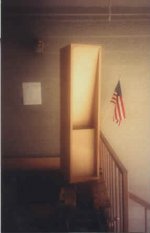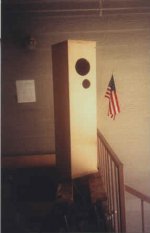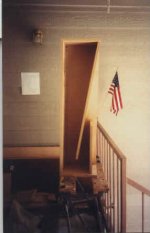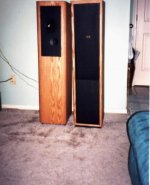Hi all,
New guy here and wanting to do my first speaker build. I've selected the Metronome and need advice on what driver to use for my room.
Here are the particulars:
1. Small room - 11.5 x 9 with 8' ceilings. It's dedicated to listening
2. Power will be a Decware Super Zen Triod 2wpc
3. Listening - almost all folk, singer songwriter and classical -- some classic rock
4. Volume - low volume to medium volume with low volume most of the time
5. Bass - don't need much, but what there is would like nice clean bass
I've never built a speaker but I've got lots of experience woodworking with a fully equipped shop. It would appear to be a straight forward build.
I've also got a couple thousand board feet of air dried Walnut, Cherry, Ash, Maple and Spalted Sycamore, so I'll be making a solid wood build.
Any advice about driver choice (with the amp I've chosen I'll need a high sensitivity driver) would be much appreciated.
Thanks,
John
New guy here and wanting to do my first speaker build. I've selected the Metronome and need advice on what driver to use for my room.
Here are the particulars:
1. Small room - 11.5 x 9 with 8' ceilings. It's dedicated to listening
2. Power will be a Decware Super Zen Triod 2wpc
3. Listening - almost all folk, singer songwriter and classical -- some classic rock
4. Volume - low volume to medium volume with low volume most of the time
5. Bass - don't need much, but what there is would like nice clean bass
I've never built a speaker but I've got lots of experience woodworking with a fully equipped shop. It would appear to be a straight forward build.
I've also got a couple thousand board feet of air dried Walnut, Cherry, Ash, Maple and Spalted Sycamore, so I'll be making a solid wood build.
Any advice about driver choice (with the amp I've chosen I'll need a high sensitivity driver) would be much appreciated.
Thanks,
John
I don't know what "lots of experience" means precisely, but be warned, this looks deceptively simple but is actually rather tricky to get right. There are a lot of weird angles and small cuts to get wrong, and performance-wise I'd not say I was blown away. It's very comparable to other MLTQWTish enclosures.
Not what I'd recommend to a first time builder.
Not what I'd recommend to a first time builder.
I don't know what "lots of experience" means precisely, but be warned, this looks deceptively simple but is actually rather tricky to get right. There are a lot of weird angles and small cuts to get wrong, and performance-wise I'd not say I was blown away. It's very comparable to other MLTQWTish enclosures.
Not what I'd recommend to a first time builder.
Thanks for the warning Sqeak. Did I mention I have a very good attitude about being frustrated. I've a lot of practice -- and a lot of wood if I have to redo somthing. I'm also retired, so I'll not be in a hurry.
I'm looking forward to the build. It looks like a fairly standard build, but a little challenge will be welcome.
John
If you are anal there are some subtly angled cuts, but in the real world 90 degrees is close enuff.
Your room is quite small, i'd be looking to FF105, FE103, FF125, FE108.
dave
Thanks Dave,
That's the information I was looking for.
Is that the FE108EΣ and the FF125wk that I would be looking at? There seems to be a lot of different letters at the end of these designations. It's a bit confusing to the uninitiated.
John
If you are anal there are some subtly angled cuts, but in the real world 90 degrees is close enuff.
Your room is quite small, i'd be looking to FF105, FE103, FF125, FE108.
dave
I've seen the plans for FF127e and like the detail. Would the FF125wk use the same plans?
Also, are the "subtly angled cuts" be the S(l) and S(o) cuts. My newbie eyes aren't picking up any other angled cuts.
John
Also, are the "subtly angled cuts" be the S(l) and S(o) cuts. My newbie eyes aren't picking up any other angled cuts
In the standard metronome, all four sides are at an angle to the vertical. As a result every single cut is angled.
Are you going to mitre every corner (normal practice with furniture grade solid wood)
In the standard metronome, all four sides are at an angle to the vertical. As a result every single cut is angled.
Are you going to mitre every corner (normal practice with furniture grade solid wood)
I hope I can explain what I've planned.
If you picture the front face of the Metronome, I'd cut both sides 3/4" narrow. Then I'll add two strips of 3/4" square contrasting wood so the glue up will be to final spec's. The sides, then, will be glued as normal. This should give the appearance of trim on all sides. All the outside edges will be rounded off. I'd like to keep the trim pieces on the corners slightly proud of the panels. I like the looks of that but I don't want to mess up the sonics.
As far as cutting a mitre on all corners, I would prefer not for the looks, but could certainly do that if needed to improve the sound.
John
As the originator of the Metronome, I hope you guys don't mind if I interject. 
There seems to have been a lot of argument over the years about the angles involved in building a Met, so I'll try to clear things up a bit.
Each vertical face of the speaker is of course angled towards the top and each side of each face is at an equal angle away from the vertical, usually around 22 degrees.
Each vertical edge of each vertical face is cut square, ie 90 degrees.
The vertical faces are easily joined as despite appearing to be compound angles, the joins between them are all simple butt joins, dead flat and dead flush without any need for any messing about.
If you have a table saw, you can pass the top and bottom of each vertical face through the saw, before assembly, with the blade set at an angle to match the slope of the side. This ensures that the enclosure will stand four square on a flat surface, and the top will be flat so that an end cap can be attached. Otherwise the legs can just be carefully planed so that the thing stands on all fours, which is what I did with mine.
A top cap with square sides can be attached then planed to match the slope.
The only slight difficulty is getting the port baffle edges angled so that it fits snugly in the base, against the battens that set the length of the horn, but a bench plane and bit of care and patience will result in success.
Apart from getting the port baffle to sit squarely inside the wide end, the enclosure is one of the simplest to build.
My original FE108ES Mets were made in my basement with nothing but a straight edge, a handsaw and a bench plane and only took a day to build.
There seems to have been a lot of argument over the years about the angles involved in building a Met, so I'll try to clear things up a bit.
Each vertical face of the speaker is of course angled towards the top and each side of each face is at an equal angle away from the vertical, usually around 22 degrees.
Each vertical edge of each vertical face is cut square, ie 90 degrees.
The vertical faces are easily joined as despite appearing to be compound angles, the joins between them are all simple butt joins, dead flat and dead flush without any need for any messing about.
If you have a table saw, you can pass the top and bottom of each vertical face through the saw, before assembly, with the blade set at an angle to match the slope of the side. This ensures that the enclosure will stand four square on a flat surface, and the top will be flat so that an end cap can be attached. Otherwise the legs can just be carefully planed so that the thing stands on all fours, which is what I did with mine.
A top cap with square sides can be attached then planed to match the slope.
The only slight difficulty is getting the port baffle edges angled so that it fits snugly in the base, against the battens that set the length of the horn, but a bench plane and bit of care and patience will result in success.
Apart from getting the port baffle to sit squarely inside the wide end, the enclosure is one of the simplest to build.
My original FE108ES Mets were made in my basement with nothing but a straight edge, a handsaw and a bench plane and only took a day to build.
As the originator of the Metronome, I hope you guys don't mind if I interject.
Far from minding, I welcome your input.
The construction part doesn't bother me as it looks pretty straight forward. Because I have a small room, and want to drive the speakers with a 2wpc SET, I'm struggling a bit with a driver choice. As stated previously, my dedicated listening room is only 9'x11.5' with 8' ceilings. I listen to, mainly, folk and classical and always at low to medium volumes. Initially I was going with the Fostex FF125wk. Thinking that may too large for my room, I'm presently leaning towards the FE108eSigma's. I'd like to go larger for more sensitivity, but it seems for my room, the 108's may be the best choice.
Any thoughts on driver selection would be greatly appreciated.
Thanks,
John
Please! (And "thank you" - both for the design and butting in)As the originator of the Metronome, I hope you guys don't mind if I interject.
Did you plane the vertical face edges after construction or can you not "read" the ever so slight edge?My original FE108ES Mets were made in my basement with nothing but a straight edge, a handsaw and a bench plane and only took a day to build.
I was looking to build in pre-veneered plywood which forces multiple mitre joints (but as the 'n'th speaker build and access to a decent shop this is not a problem). But if it's that easy with butts.....
Last edited:
Please! (And "thank you" - both for the design and butting in)
Did you plane the vertical face edges after construction or can you not "read" the ever so slight edge?
I was looking to build in pre-veneered plywood which forces multiple mitre joints (but as the 'n'th speaker build and access to a decent shop this is not a problem). But if it's that easy with butts.....
I built my originals in 18mm birch ply and there would have been no need for planing the vertical edges if I had used a hand held circular saw against a clamped, straight edge as a fence.
As they were hand sawn, there was a small amount of truing up after assembly to take out one or two slight wiggles that stood proud. Not a lot of work really.
I built my first serious speaker with a hand saw and a hand plane. They were made of MDF shelf material. Tapered TL Peerless CSX 850122 and a (I can't remember) Peerless tweeter.
Bob
Bob
Attachments
I built the metronomes and they were easy. I used a palm sander to angle the top cap and round over the front baffle. I found a protractor that can copy angels useful for squaring the "feet". Of course with experience in wood working, one should have less need for wood filler which I mostly used for s few voids in the plywood. Nice imaging from these speakers.
I find they sound best with only the back inside panel lined with felt and when they stand on a hard surface. Make sure the speaker is tight against the off-centre brace behind it. I was successful at using a jig saw for cutting the hole for the port tube.
Gorilla glue!!
I find they sound best with only the back inside panel lined with felt and when they stand on a hard surface. Make sure the speaker is tight against the off-centre brace behind it. I was successful at using a jig saw for cutting the hole for the port tube.
Gorilla glue!!
I built the metronomes and they were easy. I used a palm sander to angle the top cap and round over the front baffle. I found a protractor that can copy angels useful for squaring the "feet". Of course with experience in wood working, one should have less need for wood filler which I mostly used for s few voids in the plywood. Nice imaging from these speakers.
I find they sound best with only the back inside panel lined with felt and when they stand on a hard surface. Make sure the speaker is tight against the off-centre brace behind it. I was successful at using a jig saw for cutting the hole for the port tube.
Gorilla glue!!
Thanks for the input faithintruth. As a long time woodworker, I don't think the actual woodworking aspect will give me problems. As far as voids, I'm going to use solid wood so that won't be a problem.
Gorilla Glue certainly does the sticky thing well, but my experience has been a great big mess that's hard to clean up. I use a lot of epoxy for gluing but will probably use regular wood glue for this project.
John
I built my first serious speaker with a hand saw and a hand plane. They were made of MDF shelf material. Tapered TL Peerless CSX 850122 and a (I can't remember) Peerless tweeter.
Bob
Sweet pictures! How did you get the holes so round with hand tools (maybe they aren't?
And how did they sound?
Sweet pictures! How did you get the holes so round with hand tools (maybe they aren't??
And how did they sound?
1. Draw circle with a compass.
2. Cut hole with a keyhole saw.
3. Finish hole with a rasp.
The holes are dead on.
Interesting story about these speakers. I took them to a meet in Atlanta some ten years ago. A fellow brought a pair of Seas "Thor"s to the meet. Beautiful speakers. Solid oak and very well done. Now, the Tho'rs are a classic case of how marketing case screw of a good design. Joe D'appolito is a first class designer, and he designed the Thor's using George Augspurger's TL design software. But marketing said no, too big! So the published design is half the volume of the original and as a consequence, it has no deep bass. My single Peerless driver walked all over the twin Seas drivers. I will admit that the Seas Millennium tweeter sounded a bit better than my $30 Peerless.
Bob
- Status
- This old topic is closed. If you want to reopen this topic, contact a moderator using the "Report Post" button.
- Home
- Loudspeakers
- Full Range
- Small Room - Metronome - First Build



